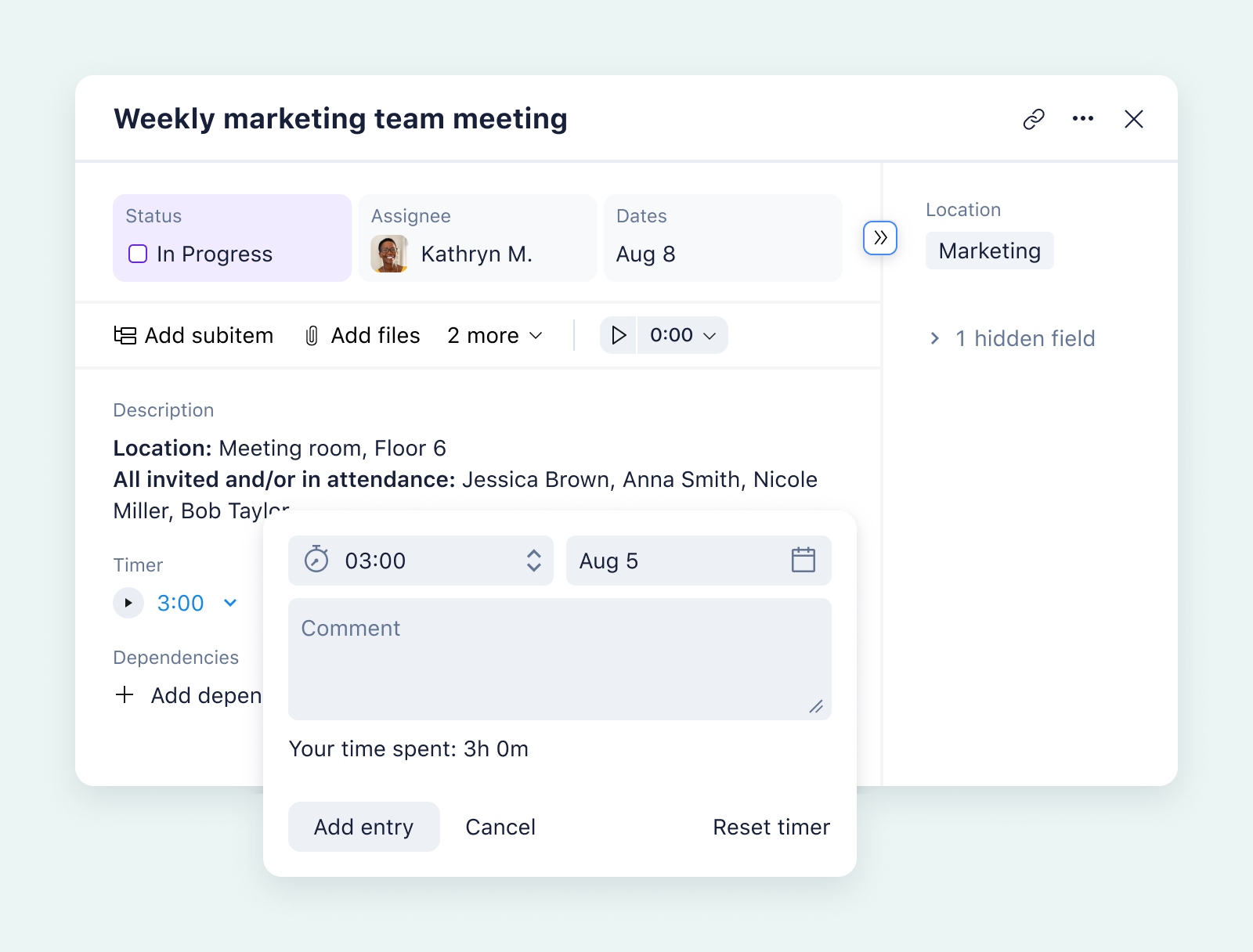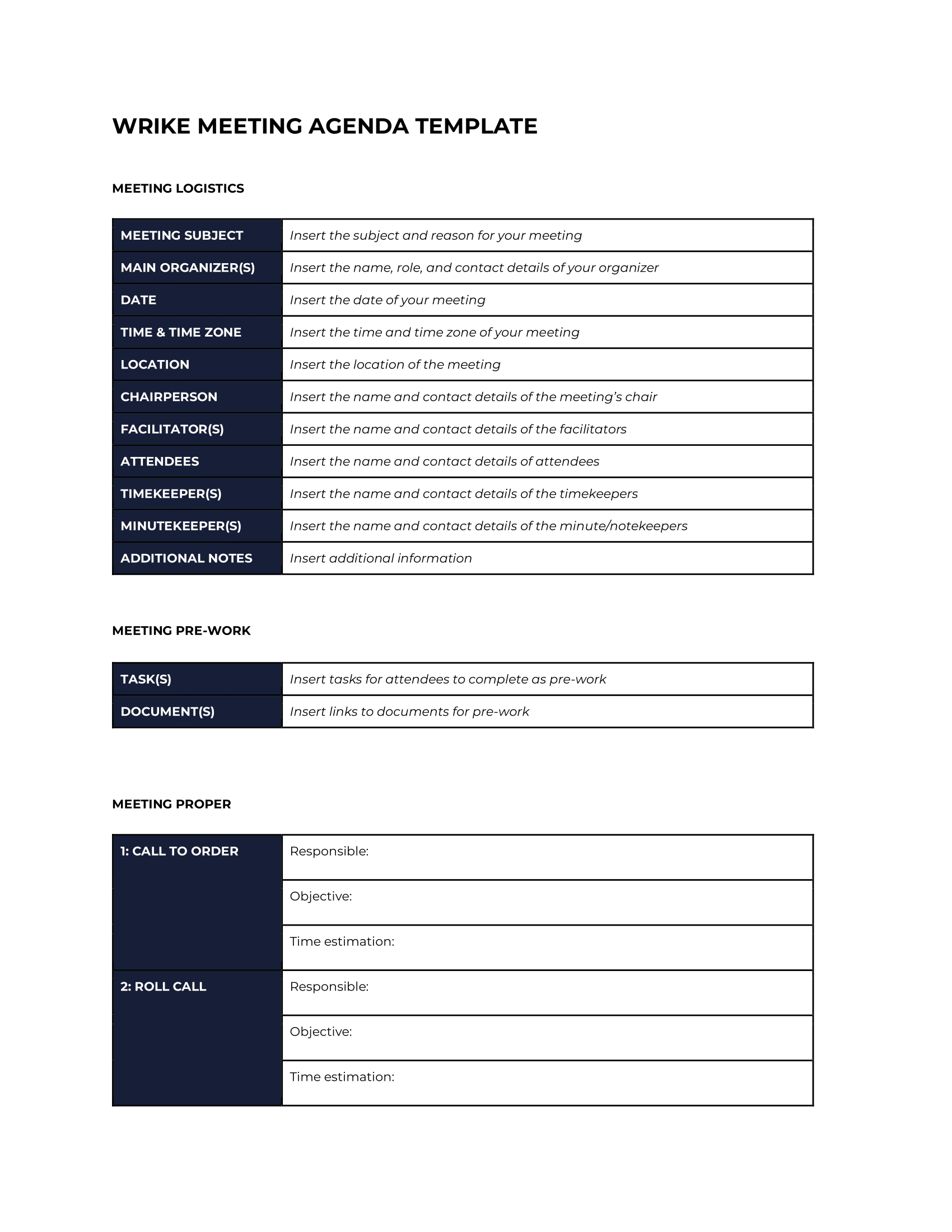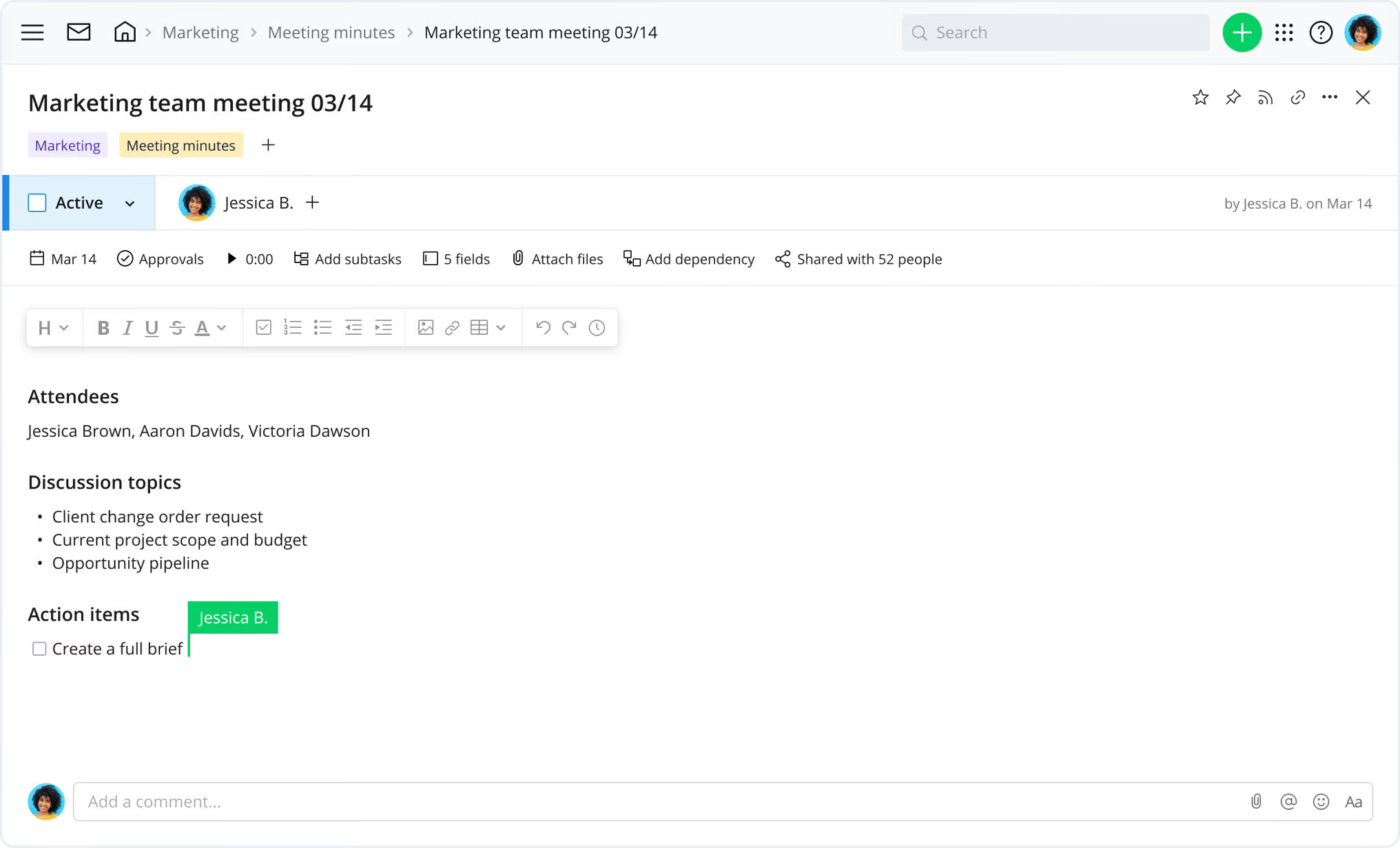Key takeaways:
- What is a meeting agenda template? It’s a customizable tool that includes key components like logistics, roles, and action items to streamline meeting planning.
- What should be included in a meeting agenda? Essential elements are logistics, participant roles, discussion topics, time management, and action items.
- How can you enhance meeting productivity? Send the agenda in advance, establish clear objectives, and allocate time for each discussion item.
- What types of meeting templates can you find? Examples include staff, weekly update, board, and team meeting templates, each with unique components.
- How does Wrike support meeting management? Wrike offers collaborative tools for creating and sharing agendas, as well as automating action item tracking post-meeting.
All good project managers know the value of creating an agenda before each meeting. But writing agendas from scratch is time-consuming. That’s where a meeting agenda template comes in handy.
In this post, you’ll find a downloadable meeting agenda template that you can customize as you wish. I’ve designed it so you have everything you’d need, so all you have to do is delete the bits you don’t want.
Read on for:
- All the essential components of a meeting agenda template
- Free downloadable meeting agenda
- 5 bonus meeting templates you can use with Wrike
What does a meeting agenda template contain?
Based on my experience running meetings at Wrike and elsewhere, I have some ideas for what a meeting agenda should contain. I’ve used these to structure the meeting agenda template below.
Logistics
Naturally, it’s important to clarify when and where the meeting will take place. But don’t forget the following nuances:
- What time zone is the meeting in? Participants in different time zones will thank you!
- Has the meeting location changed since the last meeting?
It looks professional to include the name and logo of the organization that’s meeting. If there are multiple organizations in the meeting, include names and logos for each one. For small meetings, list the attendees by name. If this is a meeting that includes senior people, consider including their job titles as well.
For larger meetings, it won’t be practical to list everyone’s name individually, so just list the departments that are attending. Either way, it’s good practice to spell out the various roles that participants have in the meeting. Include, for example:
- Who called the meeting
- Who the chairperson is, so that participants know who to direct questions to
- Who’s facilitating each part of the meeting (Sometimes, this is the same person the whole way through, but I’ve also seen meetings where the facilitator changes for each agenda item.)
- Who’s responsible for keeping time
- Who’s the note taker — assuming you want to do this manually, and not with an AI tool like Fireflies
Pre-work
List any tasks that participants need to execute before coming to the meeting itself. In my experience, this is typically either:
- Reading important documents, such as the minutes from the previous meeting or the budget for the coming quarter, or;
- Bringing certain items to the meeting, such as a laptop, employee performance review, or risk assessment report
To make sure participants have enough time for the pre-work, always send out the agenda ahead of time. This is especially important if the participants are senior and have limited time, or if the pre-work will be time-intensive (e.g. reading a risk assessment report or reviewing website performance data).
Start of the meeting

- A call to order, so that participants know to be quiet so that the meeting can begin
- A roll call to see who’s present for the meeting
- An official welcome speech
After the meeting is formally kicked off, the first few items are usually some combination of:
- Approving the minutes from the last meeting
- A warm-up activity, such as having people share something they’re grateful for in the last week
- Defining the goals for the meeting
- Announcements, such as saying that a particular participant won’t be present today, or that the meeting will be recorded
It’s possible that drinks or snacks will be served prior to the meeting. If this is the case, make a note of it in this part of the agenda.
Body of the meeting
In most meetings, you can expect the majority of the conversation to center around three to five agenda items. Agenda items could be:
- Open issues: Initiatives that were discussed in previous meetings but haven’t been fully addressed or resolved
- New business: Important topics that weren’t brought up in a previous meeting and require attention
- Roundtable discussion topics
For each point on the agenda, consider listing:
- Who’s responsible for that part of the discussion
- What’s the objective for that agenda item
- How long each one will take to discuss
Even if there’s lots to discuss, make sure that you leave sufficient time for:
- Refreshments and breaks (A good rule of thumb is to have at least five minutes as a break every hour.)
- Questions at the end (This is especially important if the majority of the meeting consisted of one or more presentations.)
- Any other business that wasn’t on the agenda
End of the meeting
Before the meeting ends, leave time on the agenda to:
- Identify any action items
- Determine who’s responsible for those
- Agree on a date by which those tasks should be completed
The note-taker should send the action items out to participants after the meeting ends. Alternatively, you could automate that with AI. The moment when the meeting formally ends is called adjournment, and your agenda should specify an exact time for this.
Assuming this is one meeting in a longer series of regular meetings, the final thing to do is to agree when and where the next meeting will take place. You can either:
- Leave space for that conversation on the agenda, or;
- Write down the details for the next meeting on the agenda if you already know them
Master template for meeting agendas (free download)
If you search online for meeting agenda templates, you’ll find many sites that offer dozens of different templates. Poring through these to find the right template for your situation can take a long time.
To save you from doing that, I’ve created the following meeting agenda template that summarizes all the points I mentioned in the previous section.
Here’s what the template looks like:

The template is designed to give you everything you could possibly need in a meeting. Simply delete the bits that don’t apply to you! After that, you’re free to customize the meeting time, discussion points, participants, and other details as much as you want.
Bonus: 5 additional outlines for meetings
Looking for a template for a particular type of meeting? For example:
- Staff meeting
- Weekly meeting
- Board meeting
- Team meeting
Check out these examples, and simply copy and paste the list into your own meeting agenda.
1. Staff meeting agenda example
This is designed to ensure that large staff meetings don’t drag on or become inefficient.
- Team updates: Introduce new members, and announce any departures or promotions.
- Team performance: Share data that relates to the whole team’s KPIs.
- Topics of interest: Give each topic a clear title so that staff can prepare accordingly.
- Action items: What needs to be completed after the meeting?
- Wrap up: Address any final questions or concerns, and call it a day.
2. Weekly meeting agenda example
This is for regular weekly meetings between a small group of people who work closely together.
- Team updates: High-level team developments that employees haven’t already been briefed on.
- Individual updates: What has each team member worked on this week? What will they tackle next week? Managers can provide guidance where necessary.
- Upcoming projects: How have these changed since the last meeting? What new tasks are there? How should team members adjust their priorities?
- Housekeeping: Share any other events or admin topics that employees need to know about.
- Action items: What needs to get done between now and next week’s meeting?
3. Board meeting agenda example
Here’s a template for a board meeting. These meetings typically happen less often than regular team meetings. The classic frequency is once a quarter.
- Call to order: The chair welcomes the board members and summarizes what you’ll be talking about today.
- Review of prior meeting’s minutes: The secretary goes over the minutes from the last meeting. The chair then calls a vote to approve those minutes.
- Old business: Are there any updates to matters that are already ongoing?
- New business: Are there any important events, initiatives, or priorities that haven’t been addressed yet?
- Open forum: Board members can bring up any additional topics they want for discussion.
- Adjournment: Thank attendees, say when the next meeting will be, and ask the secretary to get minutes distributed to attendees.
4. Team meeting agenda example
This is best used by a department, perhaps on a monthly or biweekly basis.
- Team and project updates: Give a status report on current projects, important changes, and KPIs.
- Individual updates: Each team member gives a brief update saying what they’re currently working on
- Upcoming priorities: Have priorities changed since the last meeting? Have any urgent or ad hoc projects come through the pipeline?
- Kudos: Give a shout-out to team members who were particularly engaged or successful in the last week or two.
- Action items: Ensure employees know what action they need to take after the meeting.
5. Actionable meeting notes template
This last template is different from the others in that it’s for meeting notes, rather than for a type of meeting. It’s also available via Wrike.
The template uses AI to automatically turn actionable items from your meeting notes into Wrike tasks. That way, you maximize the chances that people will take action after the meeting ends.
Here’s what the template looks like:

There’s space here for you to add attendees and discussion topics. However, you can also make this more detailed by adding some of the bullet points from some of the other agenda examples above.
To get started with this template today, click here.
How you can use Wrike to manage your meeting planning
Got your meeting template ready to go?
Here are some ways you can use Wrike to get the most out of it:
- Wrike’s collaboration tools allow multiple PMs to work on the same template simultaneously. This is handy if there are a number of people in your organization determining meeting agendas.
- Share your agenda with colleagues by attaching it to a task.
- Tag a template and put it into Wrike’s intuitive file folder system to make it easier to find later down the line.
- Use Wrike’s integration with Google Calendar to easily pull the agenda out of Wrike and send it to meeting participants.
- After the meeting, Wrike’s AI subtask creation can automatically review your notes, detect action items, and turn them into subtasks.
- You can also create additional action tasks manually, and then @mention team members to notify them.
Wrike makes creating meeting agendas easier
Creating meeting agendas from scratch can be time-consuming. But it doesn’t have to be that way!
Use one of our templates here to speed up the process of creating your agenda. Then, use Wrike to:
- Brainstorm ideas for the agenda with a colleague
- Save it with your other documentation
- Share it with colleagues and meeting participants
If that isn’t enough, you can also use our actionable meeting notes template to ensure that action items get followed up on after the meeting concludes.
So what are you waiting for? Sign up for Wrike today and use one of our templates to make your meetings run more efficiently.



